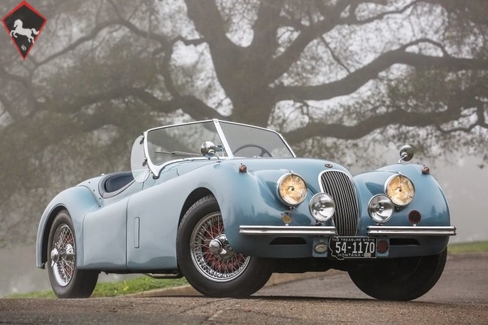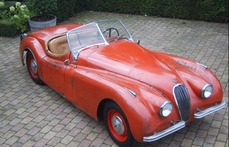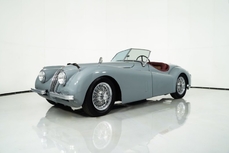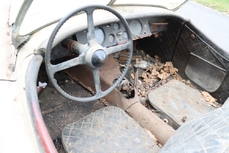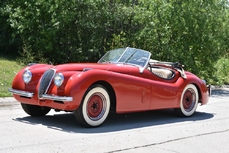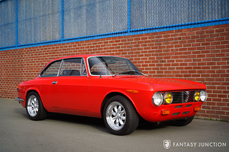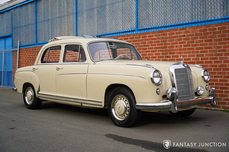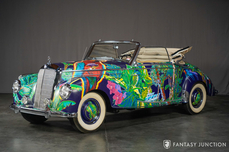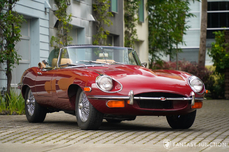Jaguar XK120 3.4 Liter Inline-6 no. F 3129-8 1954
Allgemeine Beschreibung :
1954 Jaguar XK 120 OTS
Chassis No. 675728, Engine No. F3129-8
Pastel Blue with Blue Leather Interior
It is hard to imagine the enthusiasm that greeted Jaguar when, just three years after the end of World War II, they revealed the XK 120. With the wartime austerity still very fresh, the XK120 caused quite a stir. With its stunning styling, sophisticated mechanical specification, and unapologetically sporting ethose, the XK 120 was nothing short of a revelation. The elegant and avant-garde XK 120 not only boosted morale among the weary UK population, it demonstrated to the world that Britain had both the technical capacity and design excellence to deliver a sensual and emotionally engaging car.
Although originally intended to be a concept car showcasing Jaguar’s remarkable new twin-cam inline-6 cylinder engine designed for their large sedans, the breathtaking styling and genuine 120 mph performance of the XK120, coupled with an affordable price, captured the imagination of the world. In short order, the largely hand-built aluminum-bodied car was rushed into limited production as orders came flooding in. With time and delivery pressures growing, Jaguar immediately realized they needed to reengineer the car for mass production and developed tooling to produce thousands of cars with steel bodies to meet the significant demand. This effort not only improved output, it allowed Jaguar to expand their market share exporting to North America and other parts of the world.
The car’s heart was, of course, the fabulous XK engine. Conceived in wartime, the 3.4 litre “six” embodied the best of modern design, boasting twin overhead camshafts in an aluminum-alloy cylinder head, seven main bearings, all of which produced a maximum output of 160bhp. When installed in the lightweight XK120, the result was a car with a phenomenal power-to-weight ratio and blistering performance. The “120” referred to the car’s top speed, any doubts about these claims were swiftly banished when a standard XK120 achieved a top speed of 126.4 mph with hood and side screens erected and 132.6 mph at Jabbeke with a few drag-reducing modifications including bubble canopy and belly pan. The XK120 set new standards of comfort, road holding and performance for British sports cars and, in keeping with the Jaguar tradition, there was nothing to touch it at the remarkably affordable price.
This particular XK120 is a well-known and superbly preserved example that would be extremely difficult to repeat. According to the Jaguar Heritage Trust Certificate issued in October 2016, this XK120 OTS was manufactured June 3, 1954 and dispatched to North America June 11, 1954. The original distributor, Hornburg Jaguar in Los Angeles, sold the car to the first owner, Russel Loer of Los Angeles. In 1957, Jaguar historian and XK120 Registrar for the Classic Jaguar Association Bruce Carnachan of Glendale, CA, purchased the car from the original owner with 19,000 miles. Carnachan, a former Air-Force gunner sergeant and later California Highway Patrol worker, had known of the car since new, greatly admired it and hoped one day to purchase it. Determined to retain the originality of the car, Carnachan proceeded to care for it throughout decades of remarkable ownership, participating in automotive events where he would earn the moniker “Mr. Jaguar” among his friends and enthusiasts.
Over the years, this XK120 has been featured in multiple automotive publications including a 1974 Motor Trend “Retrospect”, the cover of Car Collector 1979, and again in 1981 as a Road & Track “Salon” car. In 1981, the car showed 119,000 miles, still remaining “absolutely original” as stated by legendary automotive journalist Tony Hogg in his detailed Salon article. Throughout his six decades of ownership, Carnachan performed much of the maintenance himself, winning local concours awards, and participating in multiple rallies despite his advancing years. In 1992, the car participated in the Monterey Historic Races and continued to be shown in 2006, 2009, and 2012 as documented by dashboard plaques still affixed to the car. Carnachan’s exhaustive and highly detailed knowledge of XK120s is owed in part to the originality of this car and to Carnachan’s pioneering advocacy of authentic preservation combined with decades of impressive stewardship.
Today, the condition of this XK120 continues to reveal the ongoing care and preservation that like-minded enthusiasts have since bestowed upon the car in keeping with Carnachan’s legacy. Retaining substantially original finishes with a combination of properly serviced components and details, this XK120 is a beautiful and honest artifact of elegant motoring from a bygone era. Each of the authentic features conveys the history and integrity of past owners and their thoughtful care. Prior to consignment, the car was brought in for service as Jaguar experts determined the original twin-cam head needed to be replaced. The difficult decision was made to remove the original head, preserve it, and locate a factory original head as a replacement. A suitable head within the same month of manufacture was prepared, installed, tested, and dialed in after reassembly. This work was performed by highly-regarded Jaguar specialist Steve Gordon of Vintage Auto Service.
The car’s finish, details, and remarkably cohesive presentation truly embody the ideals of preservation and originality. The body is arrow straight and has superb integrity, with excellent panel fit and operation. The paint is older and shows a rich patina that quietly speaks volumes of history to attentive advocates of authenticity. There is some checking, some touched up areas, and the occasional chip, but it is clear that the car is extremely dry and that it has been used so carefully that its decades-old paint remains sympathetically intact. The chrome is in good to very good condition including the grille, bumpers, nicely polished headlight trim, and nicely detailed fog lamps. The windshield frame shows some expected pitting at the base, along with separating rubber gaskets originally fit to the cowl. Emblems, and minor trim including the delicate wind-wings are in excellent condition. A set of correctly sized Pirelli tires is mounted on chrome plated wire wheels featuring dual-eared knockoffs, beautifully accented by painted red drum brakes, which add a purposeful competition touch to the car. Overall the exterior visual presentation is sporty, handsomely honest, and delightfully inviting.
The interior is a welcoming blend of original components and properly sourced materials, which have been replaced only as needed. The seats are correctly tailored with proper piping and material, correctly pleated, but gently relaxed by years of enjoyable driving. Carpeting and door panels reveal varying material age evident in range from the driver’s side door pull to the replacement floor mats, which cover older replacement carpets. The dash and instrumentation are in beautiful but authentic condition, adorned by beautifully detailed markings, crisp needles, and richly contrasting dial faces. The odometer currently reads 58,000 miles and is likely representative of 158,000 original miles accumulated since new. The steering wheel, switches, gearshift lever, and emergency brake handle are all in very good condition with a few pleasant signs of aging consistent with the rest of the car’s presentation. The trunk is very much in keeping with the interior, sporting a very tidy spare tire storage area, wire wheel spare, and tools and jack, all of which appear to retain the preserved factory original finishes.
Under the hood, the beautiful matching numbers engine block sparkles with the benefit of recent freshening and correct components, which have been refined when recent work was performed on the replacement head. The polished aluminum castings are nicely hued and properly detailed, while correct factory hardware further complete the engine compartment with integrity and refinement befitting the originality of the rest of the car. The undercarriage reflects the finishes of a car that has never been restored, merely conscientiously maintained since new in a dry climate. The finishes and components remain tidy and clean with no visual evidence of structural damage or corrosion.
The car starts easily when warm, and settles down to a nice even idle. It has excellent carburetion and is well-tuned, with excellent throttle response and a pleasingly docile character that makes the car a cinch to use. The engine pulls easily through the rev range, with excellent torque, and is nicely complemented by an easy to use gearbox. Operating temperature remains well within spec even after extended idling. The ammeter and other instruments work properly including the odometer. The clutch engages positively and progressively, and the gearbox has a nice mechanical feel with well-defined gates and effective synchromesh. Brakes have good bite, are easy to modulate, and operate symmetrically, while steering and suspension are effective, precise, and free of slop. In short, the entire car has a harmonious, coherent feel where everything works well together. The driver’s overwhelming impression is of a well-resolved car that allows the driver to focus on the road and the experience instead of individual systems of the car. It is the way that all XKs should work, but few seem to ever achieve.
Included with the car is weather equipment (soft top and side curtains), car cover and bag, tire changing tools, various other small mechanical parts, the original matching numbers head, and copies of the various publications in which the car has been featured.
This is an outstanding opportunity to acquire one of the finest original and most-respected Jaguar XK120 roadsters in existence. As one of the most significant cars of the 20th century, restored examples readily come to market, however truly authentic examples with such pedigree and undisturbed character simply cannot be repeated today. This remarkable Jaguar XK120 offers the next fortunate enthusiast a rare opportunity to own and drive one of the most iconic sports cars ever built, while continuing the tradition of preservation executed by the stewards of classic Jaguar heritage who have owned this car its entire life.
http://fantasyjunction.com/cars/2193-Jaguar-XK120%20Roadster-3.4%20Liter%20Inline-6
1954 Jaguar XK120 3.4 Liter Inline-6 no. F 3129-8 is listed verkauft on ClassicDigest in Emeryville by Fantasy Junction for $119500.
Fakten der Auto
Karosserietyp : Auto Marke : Jaguar Modell : XK120 Ausführung : 3.4 Liter Inline-6 no. F 3129-8 Hubraum : 3.4 Modelljahr : 1954 Lage : Emeryville
Verkauft
Angaben Zum Verkäufer
Verkauft
People who viewed this Jaguar XK120 also viewed similar Jaguar listed at ClassicDigest
Other cars listed for sale by this dealer
über Jaguar
Ah, die Geschichte von Jaguar, von seinen Anfängen als SS Cars Ltd. bis hin zum Höhepunkt mit dem D-Typ und der Straßenversion des ikonischen E-Typs. An dieser Erzählung haftet etwas zutiefst Britisches, und ich werde sie erzählen, wie es ein britischer Journalist tun würde.Die Anfänge:
Unsere Reise in die Welt von Jaguar beginnt in den 1930er Jahren, als ein Unternehmen namens SS Cars Ltd. auftauchte. Trotz des unglücklichen Zufalls ihrer Initialen, die mit den aufkommenden politischen Spannungen in Europa zusammenfielen, begannen sie, stilvolle und leistungsorientierte Autos herzustellen. Der SS 100, der 1936 eingeführt wurde, war ein Symbol für Eleganz und Geschwindigkeit und legte den Grundstein für das, was Jaguar werden sollte.
Die Geburt von Jaguar:
Als der Schatten des Zweiten Weltkriegs näher rückte, entschied sich SS Cars Ltd. klugerweise, sich von den SS-Initialen zu distanzieren. So wurden sie 1945 offiziell zu Jaguar Cars Ltd., ein Name, der bald für britischen Luxus und Leistung stehen würde.
Die XK-Serie:
Die Nachkriegszeit von Jaguar brachte uns den XK 120, eine wahre Sensation im Jahr 1948. Mit seinem schlanken Design und einem leistungsstarken 3,4-Liter-Sechszylindermotor wurde er zum schnellsten Serienauto der Welt. Der XK 120 war die Blaupause für das, was kommen würde - Jaguars, die Stil mit Geschwindigkeit auf einzigartig britische Weise verbanden.
Die Dominanz des D-Typs:
Dann kam der D-Typ, eine wahre Rennlegende. 1954 eingeführt, gewann er in den 1950er Jahren dreimal Le Mans und zeigte die technische Kompetenz von Jaguar. Mit seiner innovativen Monocoque-Konstruktion und der ikonischen Finne hinten war der D-Typ der Höhepunkt von Jaguars Motorsporterfolgen.
Das Auftauchen des E-Typs:
Aber der wahre Wendepunkt kam 1961 mit der Einführung des E-Typs, oft von Enzo Ferrari als "das schönste Auto, das je gebaut wurde" bezeichnet. Seine lange Motorhaube, die geschwungene Karosserie und ein 3,8-Liter-Motor, der atemberaubende Leistung lieferte, machten ihn sofort zu einem Klassiker. Der E-Typ war nicht nur ein Auto; er war ein Kunstwerk auf Rädern und konnte auf der Straße 150 Meilen pro Stunde erreichen.
Straßen- und Rennsporterfolge:
Die Schönheit des E-Typs wurde durch seine Leistung auf der Rennstrecke unterstrichen. Die leichten E-Typen waren bei verschiedenen Rennveranstaltungen besonders erfolgreich und festigten den Ruf von Jaguar als eine Kraft, mit der man im Motorsport rechnen musste.
Das Zeitalter der Raffinesse:
Je tiefer wir in die Geschichte von Jaguar eintauchen, desto mehr erkennen wir, dass die 1950er und 1960er Jahre ein Zeitalter der Raffinesse und Expansion waren. Neben dem großartigen D-Typ und dem ikonischen Aufstieg des E-Typs führte Jaguar Modelle ein, die seinen Ruf für Luxus und Leistung weiter festigten.
Der MK2:
Ende der 1950er Jahre stellte Jaguar den MK2 vor, eine Sportlimousine, die Eleganz mit Leistung vereinte. Diese elegante viertürige Limousine war sowohl bei Bankräubern als auch bei der Polizei aufgrund ihrer außergewöhnlichen Geschwindigkeit und Handhabung beliebt. Der MK2 war ein Symbol für Jaguars Fähigkeit, Raffinesse mit Leistung zu verbinden und hatte auch eine erfolgreiche Rennkarriere.
Der XJ6:
Springen wir ins Jahr 1968, als Jaguar ein Auto auf den Markt brachte, das Jahrzehnte lang Luxuslimousinen definieren würde - den XJ6. Es war ein Meisterwerk der Ingenieurkunst und des Designs, mit einem sanften Reihensechszylindermotor, unabhängiger Hinterachse und einem geräumigen, wunderschön ausgestatteten Innenraum. Der XJ6 war ein Symbol britischer Eleganz und bot eine so sanfte Fahrt, dass es schien, als würde er förmlich über die Straße gleiten. Er wurde zum Flaggschiffmodell für Jaguar und setzte den Maßstab für Luxuslimousinen und zeigte ein Maß an Raffinesse, das die Konkurrenz staunen ließ.
Die Verschmelzung von Klassik und Moderne:
Während der MK2 und der XJ6 die Evolution der Limousinen von Jaguar repräsentierten, bewahrten sie das Engagement der Marke für Leistung und Luxus. Diese Autos gehörten nicht nur auf die Rennstrecke; sie fühlten sich genauso wohl auf den Prachtstraßen wie auf einer entspannten Fahrt durch die englische Landschaft.
Die Herausforderungen des Wandels:
Dennoch sah sich Jaguar mit dem Eintritt der 1970er Jahre, wie viele britische Automobilhersteller, finanziellen Herausforderungen und Veränderungen in der Eigentümerschaft gegenüber. Die Ära von British Leyland brachte sowohl Chancen als auch Schwierigkeiten mit sich, während die Marke durch verschiedene Fusionen und Übergänge navigierte.
Das Erbe des MK2 und des XJ6, zusammen mit dem D-Typ und dem E-Typ, definiert Jaguar weiterhin als einen Hersteller, der zeitlose Eleganz mit einer Leistungsstärke vereint. Diese klassischen Modelle, ob sie über kurvige Straßen gefahren oder als Sammlerschätze geparkt werden, dienen als Zeugnis für die anhaltende Präsenz von Jaguar in der Welt der automobilen Exzellenz.
Die Jaguar-Geschichte, von ihren Anfängen als SS Cars Ltd. bis zur Schaffung von Automobilikonen wie dem E-Typ, dem MK2 und dem XJ6, ist eine Reise, die das Wesen des britischen Automobilbaus widerspiegelt - eine Mischung aus Luxus, Leistung und Stil, die nach wie vor Enthusiasten und Kenner gleichermaßen fasziniert.
